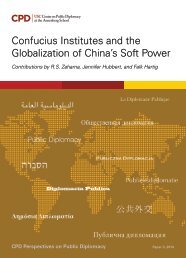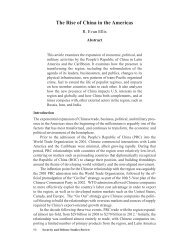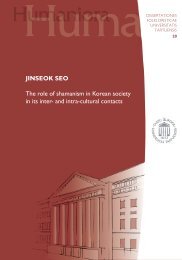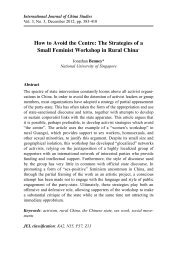JennyChan.PhDThesis.2014.FINAL
JennyChan.PhDThesis.2014.FINAL
JennyChan.PhDThesis.2014.FINAL
Create successful ePaper yourself
Turn your PDF publications into a flip-book with our unique Google optimized e-Paper software.
Class Consciousness and Collective Actions<br />
Capitalist industrialization has greatly transformed labor relations in the European<br />
countries since the late 18 th century. Large factories amassed peasants turned workers<br />
in a specific mode of production, of which the primary goal is to maximize profits.<br />
Karl Marx distinguishes between “class in itself” and “class for itself” of nascent<br />
industrial workers:<br />
Economic conditions first transformed the mass of the people of the<br />
country into workers. The combination of capital has created for this<br />
mass a common situation, common interests. The mass is thus already<br />
a class as against capital, but not yet for itself. In the struggle…the<br />
mass bedcomes united, and constitutes itself as a class for itself. The<br />
interests it defends become class interests. But the struggle of class<br />
against class is a political struggle. 72<br />
At the end of the 19 th century, foreign-owned factories began moving into coastal<br />
China. With the inflow of industrial capital, local businessmen and compradors<br />
gained more share in the emerging domestic and international markets. Port cities<br />
such as Shanghai, Tianjin, and Guangzhou were magnets of young adults, peasants<br />
and locals, to find new jobs.<br />
In the 1920s, despite the small number of factory workers, miners, rickshaw pullers,<br />
seamen, dockers, railway workers, and postal workers — an estimated 4 million<br />
throughout urban China 73 — the militancy of labor in major economic sectors<br />
should not be underestimated. The maturity of the first-generation proletarians in<br />
early Chinese industrial capitalism was evident in their broad demand for humane<br />
treatment and social and economic rights. French historian Jean Chesneaux 74<br />
highlighted the significant contributions of Chinese workers in the nationalist<br />
revolutions during the eight years of struggles between 1919 75 and 1927, when the<br />
72 Karl Marx, [1847] 1995, Poverty of Philosophy, New York: Prometheus Books, pp. 188-89.<br />
73 Lynda Norene Shaffer, 1983, “The Chinese Working Class: Comments on Two Articles,” Modern<br />
China 9(4), p. 461.<br />
74 Jean Chesneaux’s monumental research findings in The Chinese Labor Movement 1919-1927 was<br />
first published in French in 1962. The English translation by H. M. Wright appeared in 1968 (Stanford,<br />
California: Stanford University Press).<br />
75 Chow Tse-tsung’s The May Fourth Movement: Intellectual Revolution in Modern China<br />
(Cambridge, MA: Harvard University Press, 1960), now more than half a century, is still one of the<br />
most important studies of the 1919 May Fourth period. Chow defined the Movement from 1917 to<br />
1921, while some scholars extended it from 1915 (when the ew Youth magazine was published) to<br />
1925 (when the May Thirtieth tragedy happened in Shanghai).<br />
24






